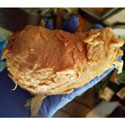
A lash egg is a mess of vaguely egg-shape coagulated gunk, sometimes including bits of egg and egg shell, that results from infection somewhere within a hen’s oviduct. So, even though the thing might be laid by a hen, it’s not really an egg.
Actually it’s not even a lash. The original definition of a lash egg is a soft-shell egg. This new definition came about apparently because the term lash egg is more user friendly than the technically correct term — caseous exudate. The disgusting rubbery mass also has been called, appropriately, a Pus Coagulegg.
Signs and Causes
Caseous exudate is an accumulation of damaged tissue and pus-like fluid that solidifies into a yellow cheesy consistency. When appearing as a lash egg, it results from an inflammation of the oviduct. The inflammation, technically known as salpingitis, is generally caused by a bacterial infection, most commonly resulting from Escherichia coli (E. coli) or Mycoplasma bacteria, but is sometimes triggered by a virus.
This infection typically affects high-producing hens, because their egg laying muscles tend to be more relaxed, allowing fecal bacteria to migrate up the oviduct. It may also result from some other disease, such as a respiratory infection, that migrates into the oviduct. Obese hens and older hens are particularly susceptible, which is why lash eggs appear in backyard flocks that are kept into old age as pampered pets.
An affected hen initially may show no sign of disease but will eventually lay fewer eggs or stop laying altogether. Instead, the material that would normally develop into eggs accumulates and festers in the oviduct, which becomes filled with a mass that looks like cooked yolks, smells bad, and may include eggshells, membranes, or intact eggs. The mass may grow so large the hen cannot release it, or it may be laid in the nest as if it were a regular egg. When cut open, the lash egg will appear as concentric layers of material, which accumulated as the mass moved through the hen’s oviduct as if it were a real egg.
An early sign of salpingitis is consistently laying soft or wrinkled eggs. Other signs include a reduction in laying, swollen abdomen, standing like a penguin, and straining as if to lay an egg — signs that are also typical of egg binding. An early infection may in fact result from egg binding. If the hen is unable to pass the lash egg, it will continue to accumulate material until it becomes so large it interferes with the hen’s ability to breath.
Treatment and Prevention
When caught early, salpingitis resulting from a bacterial infection may respond to an appropriate antibiotic. Antibiotics for poultry use may be legally obtained only by veterinary prescription, and at any rate a lab report is required to determine what kind of bacteria caused the infection and therefore which antibiotic should be used for treatment.
More often, by the time you see a lash egg, the infection is too far along to respond to treatment. Most affected hens die within 6 months of becoming infected. A hen that survives is unlikely to return to normal laying, or lay at all.
Salpingitis and the laying of lash eggs is not itself a contagious condition. However, the original cause of salpingitis might well be contagious. If more than one hen is affected, consulting a qualified poultry veterinarian would be a wise move.
Preventing salpingitis involves obtaining chicks or chickens from a disease-free source and maintaining a healthful environment that includes good ventilation (to prevent weakening of a hen’s immune system from respiratory illness) and good litter management (to minimize the accumulation of pathogenic bacteria in the coop). Using nipple drinkers, or changing the drinking water often, minimizes the presence of potentially infective droppings in the water. A properly balanced diet helps keep chickens healthy, and the addition of probiotics can help maintain healthy bacteria in the hens’ digestive system.
And that’s today’s news from the Cackle Coop.
Gail Damerow, author, The Chicken Health Handbook


I just killed one of my hens, who never laid eggs (I had her for 4 months). She always appeared somewhat sick, but much more so in the last days, so I killed her. Her abdominal cavity was swollen, and when I cut it, first a yellow liquid poured out, and then I found inside her a *lot* of yellow slumps. looking like boiled yolk. I think this is the condition you describe. My question is: Is her meat safe to eat?
On the precautionary side, I would say no. I personally wouldn’t.
thanks for your informationt
Last night I thought one of my chickens laid a lash egg. But I read this and concluded they did not!
Luckily I found out about this before too late, thanks in advance, really informative and throughful.
It’s very useful thanks you!